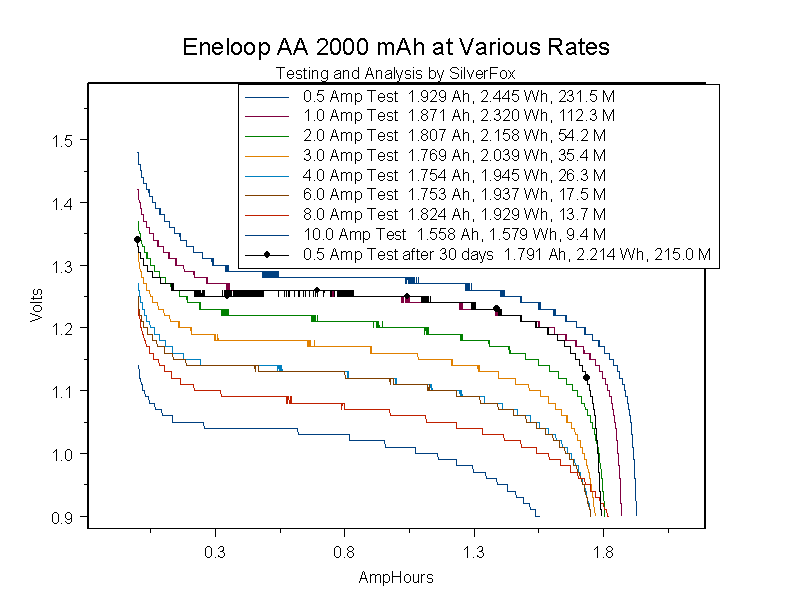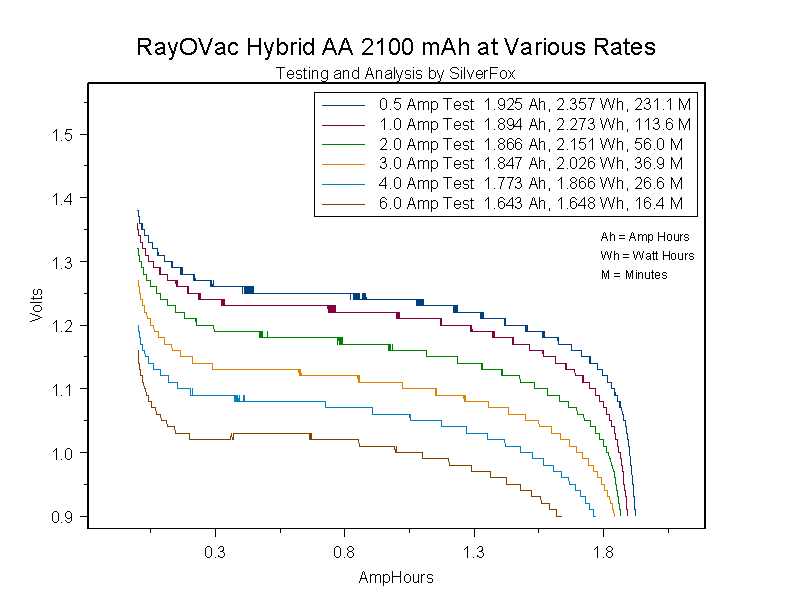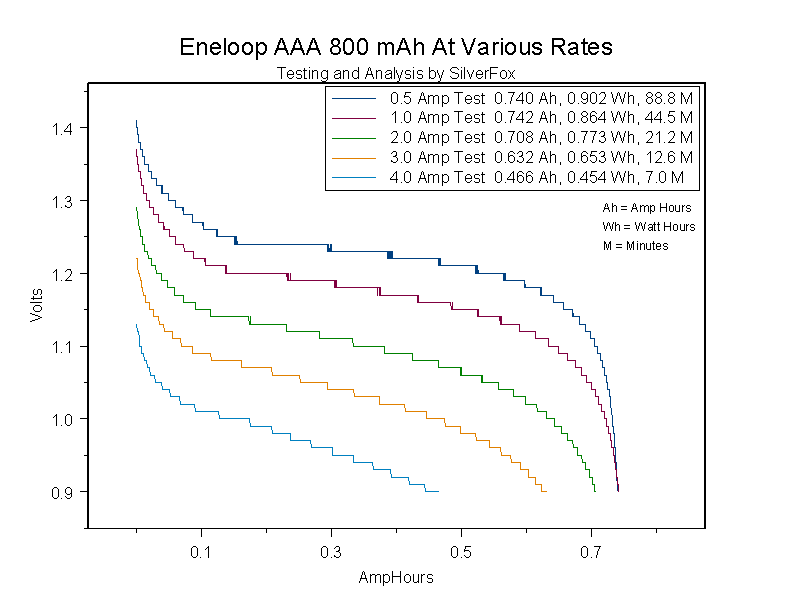SilverFox
Flashaholic
Sanyo started the ball rolling with low self discharge NiMh cells with the introduction of their Eneloop cells. I, along with several others, have been testing these cells for roughly a year now and they seem to be holding up to the manufacturers claims.
Sanyo claims 2000 mAh for their AA cells, and we are finding that to be very close. Sanyo claims that they can be used right off the shelf, and that also seems to be true. Sanyo also claims a cycle life of 1000 charge/discharge cycles. I would love to be in a position to check this out, but, for now at least, we will just have to believe them on this. The final claim is that they will still have 85% of their initial capacity after 1 year of room temperature storage.
This is what I found:
Here is the initial test data on these cells

You can see that they are very strong performers. I even included the data from the 30 day self discharge for comparison.
I then took a pair of cells and stored them on a shelf in my house. Data was taken at 0, 30, 90, and 180 days. Here is what that data looks like.

You can see that the biggest drop in capacity comes in the first 30 days. After that, things settle down. Looking at the numbers we have about 93% of the initial Amp Hours after 30 days and about 91% of the initial Watt Hours for the same time period. At 90 days we have about 88% of the initial Amp Hours and about 85% of the initial Watt Hours. At 180 days we have about 86% of the initial Amp Hours and about 82% of the initial Watt Hours.
I can easily see how these cells could still have 85% of their initial capacity at the end of a year. I am only going to project out to the year mark because I am going to be using my cells. Someone else can do the 1 year testing…
I did not note the voltage of the cells at 30 and 90 days, but at 180 days each cell was at 1.313 open circuit resting volts.
Update: 3/17/08
I just finished testing a set of 9 cells that I normally use in my Mag85. I set them aside a year ago and just finished testing them. Under a 1 amp load, they came in at 1578 mAh. Initially they came in at 1871 mAh, so you can see that they did not live up to their 85% remaining charge after a year of storage.
However, 84.34% is pretty close...
Several people have reported their self discharge test results and they seem to be quite low for normal NiMh cells. A lot of published information has NiMh cells in the 0.5-1% per day self discharge range. I was seeing around 0.7% per day with several brands of cells, based on short term tests of around 30 days. This seems to still be a little high for healthy cells. The problem 2500 mAh cells will completely self discharge in around 10 days so keep in mind that I do not consider those cells "healthy."
Here is a graph of NiMh self discharge rates comparing original cell chemistry to the Eneloop cell chemistry.

The 0.7% per day line is pretty close to what I, and others, have reported, but it seems to be pessimistic at 90 days and beyond.
The question of the suitability of the Eneloop cells for use in a remote control or other low drain device has often come up. We know that the self discharge rate is faster early on, then it tapers off. I was concerned that there would be little difference between the normal chemistry rate and the Eneloop chemistry rate, initially, and there might be little advantage in using the Eneloop cells in applications like this. This study indicates that even at the 30 day self discharge rate, the Eneloop chemistry is a lot better.
Ray (Codeman) ran some discharge tests on some Eneloop cells that had been stored for 12 months. The have a manufacturing date indicating that they are 19 months old. You can find his results in this post. Thanks Ray.
Unfortunately we don't know how much charge they initially had. Sanyo Europe stated that they were putting around a 70% charge into the cells, and we are assuming that this practice is universal, and has been in place since the cells were first introduced.
MorePower sent me some RayOVac Hybrid cells to check out. Thanks.
I will be following the same testing proceedure I used for the Eneloop cells.
Here are the initial test results.

Here are the results from the self discharge study on the Hybrid cells. I will add data as it becomes available. I am using the same storage and testing conditions as I did with the Eneloop cells. The test results are from a 0.50 Amp test.

The Hybrid cells are better than normal NiMh cells, but not quite as good as the Sanyo cells.
Cannesahs picked up some GP ReCyko AA cells for me. Thanks Jyrki.
The capacity of the battery was not labeled, so I guessed at 2050 mAh. EDIT: They are labeled as 2100 mAh and 2050 mAh minimum. ENDEDIT These are very strong cells. I was surprised that they almost held up over 1.0 volts at 10 amps. I think the voltage of the Eneloop cells is a little higher, but these are very strong cells.
Here is the initial data.

It will be interesting to see what their self discharge rate is. Testing in progress...
Here is some test data from the Eneloop AAA cells.

And here is the self discharge study on these cells.

There doesn't seem to be much self discharge between 30 and 90 days. The odd numbers are from slight differences in the cells. I used 4 cells for these tests and rotated them in pairs for the various test periods.
Update 5/23/2009
In March of 2006 I ordered and set aside some AAA Eneloop cells. I just got around to needing them and decided to see what they had left in them as far as capacity goes. Over the last three years they have been stored at room temperature.
They ended up with about 550 mAh left. This is about 74% of their original capacity...
Not too bad...
Tom
Sanyo claims 2000 mAh for their AA cells, and we are finding that to be very close. Sanyo claims that they can be used right off the shelf, and that also seems to be true. Sanyo also claims a cycle life of 1000 charge/discharge cycles. I would love to be in a position to check this out, but, for now at least, we will just have to believe them on this. The final claim is that they will still have 85% of their initial capacity after 1 year of room temperature storage.
This is what I found:
Here is the initial test data on these cells

You can see that they are very strong performers. I even included the data from the 30 day self discharge for comparison.
I then took a pair of cells and stored them on a shelf in my house. Data was taken at 0, 30, 90, and 180 days. Here is what that data looks like.

You can see that the biggest drop in capacity comes in the first 30 days. After that, things settle down. Looking at the numbers we have about 93% of the initial Amp Hours after 30 days and about 91% of the initial Watt Hours for the same time period. At 90 days we have about 88% of the initial Amp Hours and about 85% of the initial Watt Hours. At 180 days we have about 86% of the initial Amp Hours and about 82% of the initial Watt Hours.
I can easily see how these cells could still have 85% of their initial capacity at the end of a year. I am only going to project out to the year mark because I am going to be using my cells. Someone else can do the 1 year testing…
I did not note the voltage of the cells at 30 and 90 days, but at 180 days each cell was at 1.313 open circuit resting volts.
Update: 3/17/08
I just finished testing a set of 9 cells that I normally use in my Mag85. I set them aside a year ago and just finished testing them. Under a 1 amp load, they came in at 1578 mAh. Initially they came in at 1871 mAh, so you can see that they did not live up to their 85% remaining charge after a year of storage.
However, 84.34% is pretty close...
Several people have reported their self discharge test results and they seem to be quite low for normal NiMh cells. A lot of published information has NiMh cells in the 0.5-1% per day self discharge range. I was seeing around 0.7% per day with several brands of cells, based on short term tests of around 30 days. This seems to still be a little high for healthy cells. The problem 2500 mAh cells will completely self discharge in around 10 days so keep in mind that I do not consider those cells "healthy."
Here is a graph of NiMh self discharge rates comparing original cell chemistry to the Eneloop cell chemistry.

The 0.7% per day line is pretty close to what I, and others, have reported, but it seems to be pessimistic at 90 days and beyond.
The question of the suitability of the Eneloop cells for use in a remote control or other low drain device has often come up. We know that the self discharge rate is faster early on, then it tapers off. I was concerned that there would be little difference between the normal chemistry rate and the Eneloop chemistry rate, initially, and there might be little advantage in using the Eneloop cells in applications like this. This study indicates that even at the 30 day self discharge rate, the Eneloop chemistry is a lot better.
Ray (Codeman) ran some discharge tests on some Eneloop cells that had been stored for 12 months. The have a manufacturing date indicating that they are 19 months old. You can find his results in this post. Thanks Ray.
Unfortunately we don't know how much charge they initially had. Sanyo Europe stated that they were putting around a 70% charge into the cells, and we are assuming that this practice is universal, and has been in place since the cells were first introduced.
MorePower sent me some RayOVac Hybrid cells to check out. Thanks.
I will be following the same testing proceedure I used for the Eneloop cells.
Here are the initial test results.

Here are the results from the self discharge study on the Hybrid cells. I will add data as it becomes available. I am using the same storage and testing conditions as I did with the Eneloop cells. The test results are from a 0.50 Amp test.

The Hybrid cells are better than normal NiMh cells, but not quite as good as the Sanyo cells.
Cannesahs picked up some GP ReCyko AA cells for me. Thanks Jyrki.
The capacity of the battery was not labeled, so I guessed at 2050 mAh. EDIT: They are labeled as 2100 mAh and 2050 mAh minimum. ENDEDIT These are very strong cells. I was surprised that they almost held up over 1.0 volts at 10 amps. I think the voltage of the Eneloop cells is a little higher, but these are very strong cells.
Here is the initial data.

It will be interesting to see what their self discharge rate is. Testing in progress...
Here is some test data from the Eneloop AAA cells.

And here is the self discharge study on these cells.

There doesn't seem to be much self discharge between 30 and 90 days. The odd numbers are from slight differences in the cells. I used 4 cells for these tests and rotated them in pairs for the various test periods.
Update 5/23/2009
In March of 2006 I ordered and set aside some AAA Eneloop cells. I just got around to needing them and decided to see what they had left in them as far as capacity goes. Over the last three years they have been stored at room temperature.
They ended up with about 550 mAh left. This is about 74% of their original capacity...
Not too bad...
Tom
Last edited:


